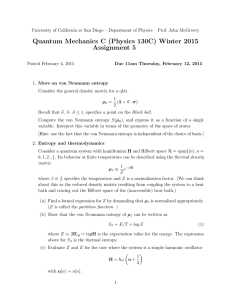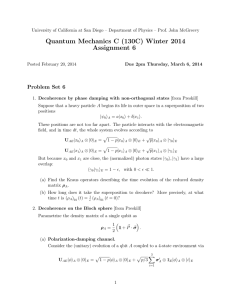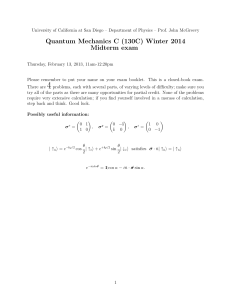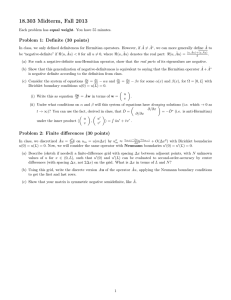Quantum Mechanics (Physics 212A) Fall 2015 Assignment 3
advertisement
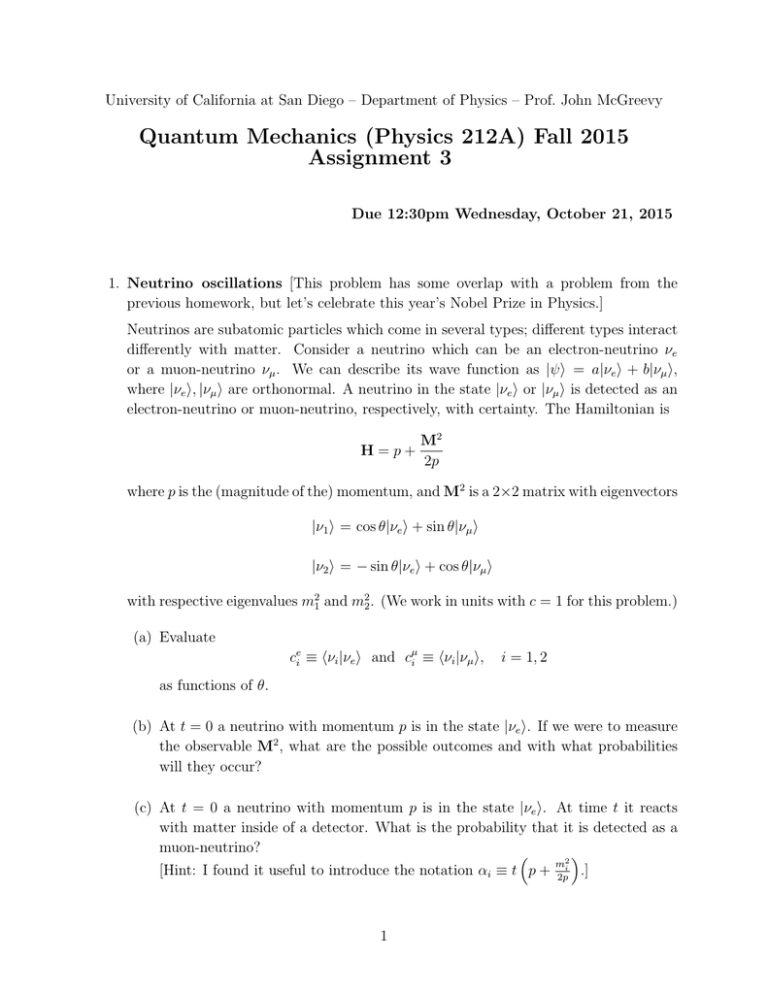
University of California at San Diego – Department of Physics – Prof. John McGreevy Quantum Mechanics (Physics 212A) Fall 2015 Assignment 3 Due 12:30pm Wednesday, October 21, 2015 1. Neutrino oscillations [This problem has some overlap with a problem from the previous homework, but let’s celebrate this year’s Nobel Prize in Physics.] Neutrinos are subatomic particles which come in several types; different types interact differently with matter. Consider a neutrino which can be an electron-neutrino νe or a muon-neutrino νµ . We can describe its wave function as |ψi = a|νe i + b|νµ i, where |νe i, |νµ i are orthonormal. A neutrino in the state |νe i or |νµ i is detected as an electron-neutrino or muon-neutrino, respectively, with certainty. The Hamiltonian is H=p+ M2 2p where p is the (magnitude of the) momentum, and M2 is a 2×2 matrix with eigenvectors |ν1 i = cos θ|νe i + sin θ|νµ i |ν2 i = − sin θ|νe i + cos θ|νµ i with respective eigenvalues m21 and m22 . (We work in units with c = 1 for this problem.) (a) Evaluate cei ≡ hνi |νe i and cµi ≡ hνi |νµ i, i = 1, 2 as functions of θ. (b) At t = 0 a neutrino with momentum p is in the state |νe i. If we were to measure the observable M2 , what are the possible outcomes and with what probabilities will they occur? (c) At t = 0 a neutrino with momentum p is in the state |νe i. At time t it reacts with matter inside of a detector. What is the probability that it is detected as a muon-neutrino? [Hint: I found it useful to introduce the notation αi ≡ t p + 1 m2i 2p .] (d) [bonus] Restore the factors of c. 2. Density operator is non-negative. Show that even if the states |αi i are not orthogonal, the density operator ρ = is non-negative, in the sense that P i pi |αi ihαi | hψ|ρ|ψi ≥ 0 ∀ψ. Check that this condition implies that all eigenvalues of ρ are non-negative. 3. Density operators for two-state systems. For the case of a single qbit, the most general density matrix is a hermitian 2 × 2 matrix, so can be written 1 ρ = n0 1 + ni σ i . 2 Find the restrictions on the na from the properties of the density matrix. What is the geometry of the space of allowed ~n ? Which ones are the pure states? 4. A density operator is a probability distribution on quantum states. [from A. Manohar] An electron gun produces electrons randomly polarized with spins up or down along one of the three possible radomly selected orthogonal axes 1, 2, 3 (i.e. x, y, z), with probabilities 1 1 pi,↑ = di + δi 2 2 1 1 pi,↓ = di − δi 2 2 i = 1, 2, 3 (1) Probabilites must be non-negative, so di ≥ 0 and |δi | ≤ di . (a) Write down the resultant density matrix ρ describing our knowledge of the electron spin, in the basis | ↑i, | ↓i with respect to the z axis. (b) Any 2 × 2 matrix ρ can be written as ~ ρ = a 1 + ~b · σ (2) in terms of the unit matrix and 3 Pauli matrices. Determine a and ~b for ρ from part (a). (c) A second electron gun produces electrons with spins up or down along a single axis in the direction ň with probabilities (1 ± ∆)/2. Find ň and ∆ so that the electron ensemble produced by the second gun is the same as that produced by the first gun. 2 5. Purity test. [from Chuang and Nielsen] Show that for any density matrix ρ: (a) trρ2 ≤ 1 (b) the inequality is saturated only if ρ is a pure state. [Hint: don’t forget that the trace operation is basis-independent.] 6. Polarization. [from Boccio] In the expression for the general density matrix of a qbit 1 ~ ρ= 1 + P~ · σ 2 the vector P~ is called the polarization. (a) To justify this name, show that it gives the expectation for the spin operator in the state ρ: P~ = h~ σ iρ . (b) Subject the qbit to a external magnetic field, which couples by ~ ~ = − γ σ · B. H = −~ µ·B 2 (γ is called the gyromagnetic ratio.) Assuming the qbit is isolated, so that its time evolution is unitary, what is the time evolution of the polarization, ∂t P~ ? 7. von Neumann entropy. Consider again the general density matrix for a qbit, ρ~n = 1 (1 + ~n · σ) . 2 Recall that ~n, ~n · ~n ≤ 1, specifies a point on the Bloch ball. Compute the von Neumann entropy S(ρ~n ) of this operator; it is defined in general as S(ρ) ≡ −trρ log ρ. Express the answer as a function of a single variable. Interpret this variable in terms of the geometry of the space of states. [Hint: use the fact that the von Neumann entropy is independent of the choice of basis.] 3
